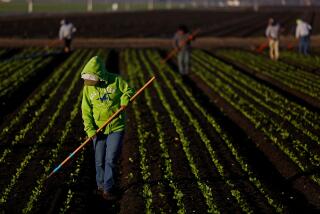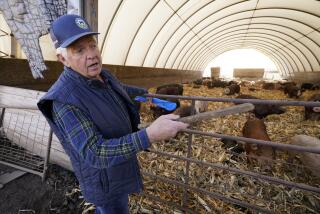New Food Label to Certify Humane Treatment of Animals
A groundbreaking new food label to be unveiled today--conceived and championed by animal rights activists--will let consumers choose not only what goes into the beef, poultry and dairy products they buy, but how the animals themselves were treated.
Under the new certification standards developed by the American Humane Assn., farmers will be able to display the “Free Farmed” label on their package. It’s the first animal-welfare label to be overseen by the U.S. Department of Agriculture.
For the record:
12:00 a.m. Sept. 21, 2000 For the Record
Los Angeles Times Thursday September 21, 2000 Home Edition Business Part C Page 2 Financial Desk 1 inches; 29 words Type of Material: Correction
UC Davis specialist--The name of UC Davis extension veterinary specialist Carolyn Stull was incorrectly reported in a Wednesday article about the American Humane Assn.’s new “Free Farmed” food label.
Farm Animal Services, a division of AHA, will administer and monitor the program, and the USDA will audit its results to verify its inspection process. In general, the standards require that animals be provided with more room, cleaner conditions and proper nutrition.
Concern for farm-animal welfare in this country, once limited to activist groups and natural-food companies, now appears to be moving into the food mainstream. Even fast-food giant McDonald’s Corp. recently demanded more comfortable conditions for hens.
Critics say it’s just a marketing gimmick designed to exploit the guilt of baby boomers and eco-conscious Generation Y. Federal and state guidelines, they say, already ensure that farmers treat their animals in a humane way. Animals who are treated with care are more productive, they say, a fact not ignored by most farmers.
So far, three companies, Petaluma, Calif.-based Clover-Stornetta Farms, Port Washington, Wis.-based Egg Innovations and Missoula, Mont.-based Meyer Natural Angus, are participating in the program. Their new packaging will hit natural-food stores and a few other supermarkets in coming weeks.
However, AHA officials ultimately hope to get enough large poultry, beef and hog producers participating in the program to get these certified products into mainstream supermarkets.
“This is just the first day of what we hope will be a far-reaching program,” said Adele Douglas, executive director of the program. “I think the potential is terrific.”
Already a similar program in Britain called Freedom Farms, which was developed by the Royal Society for the Prevention of Cruelty to Animals, makes up 20% of the poultry sold in Tesco supermarkets, she said.
Marketing experts said consumers flush in a booming economy or now looking beyond just what goes into their food, such as pesticides or hormones, are also making choices based on how these animals are being raised and what practices they are supporting.
“When consumers are feeling a little more flush, they begin to turn their attention to issues in their own backyard,” said Boston-based marketing expert Carol Cone. “Many baby boomers are in a state now where they have accumulated enough wealth, their kids are off at college and they are asking, ‘What will be my legacy?’ ”
Indeed, a study by the Animal Industry Foundation, an agribusiness trade group, found that 44% of consumers would pay as much as 5% more for beef and poultry labeled as “humanely raised.”
“Consumers are getting back to basics of where does this product come from,” said Dan Benedetti, president of Clover-Stornetta. “They are questioning the whole agribusiness system of food production.”
The program is paid for by producer fees and minimal royalties paid to FAS to cover the cost of operating the program.
Some farm industry groups rejected the new labels as unnecessary.
“We feel we are humanely treating our animals,” said Bill Mattos, president of the California Poultry Industry Federation. “They wouldn’t produce like they do or grow and be healthy if we were abusing them in some way.”
Kathleen Merrigan, administrator of USDA’s Agricultural Marketing Service, stressed that her agency is not endorsing the program, just auditing its certifications. But marketing experts said that by supporting the process, USDA’s move speaks volumes about what they believe consumers want.
“It’s interesting that there was enough of an outcry for them to do this,” Cone said. “We have such an overabundance here that the consumer is now in control.”
The comprehensive set of guidelines calls for chickens--including those that lay eggs--to be cage-free and free roaming. It forbids the practice of starvation-induced molting, which is the natural process that restores a hen’s ability to lay eggs. Guidelines are also in place for how to stun broiler chickens before they are killed.
Cows must not be fed hormones, must have shade and sprinklers in hot environments and be able to walk around. They also must be kept in a relatively clean environment, said Marilyn Stull, a UC Davis extension veterinary specialist. And to be killed for meat, they must be healthy enough to walk off the farm.
Adopting these practices and building the proper facilities could raise producers’ costs as much as 10% to 15%, Stull says.
But, Clover-Stornetta’s Benedetti insisted the labeling elevates their product above commodity level and gives small farmers, such as the ones who supply his company, a more profitable niche in which to operate.
More to Read
Inside the business of entertainment
The Wide Shot brings you news, analysis and insights on everything from streaming wars to production — and what it all means for the future.
You may occasionally receive promotional content from the Los Angeles Times.










